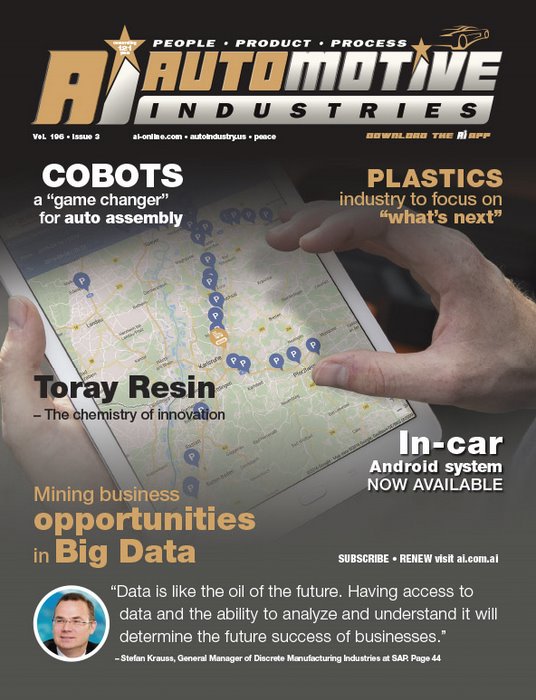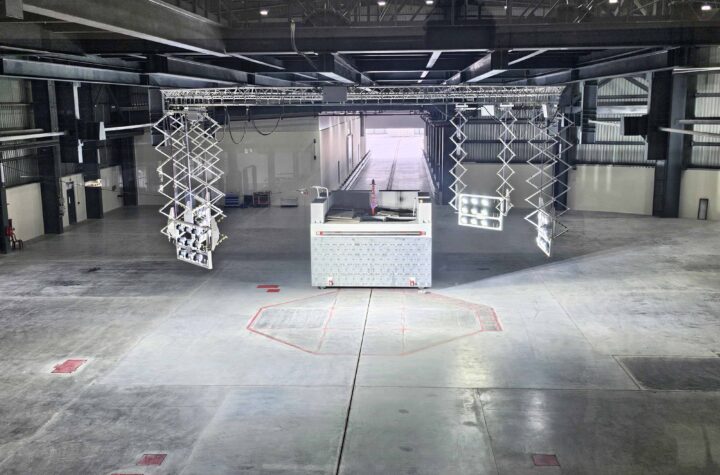
It is estimated that by 2020 there will be about 250 million connected vehicles on the road all of which will be collecting, generating and sharing unprecedented amounts of data.
McKinsey predicts that the data from connected cars will be worth $1.5 trillion by 2030. Data creates both threats and opportunities for OEMs, who will need to change their business models and processes in order to take full advantage of the opportunities opened up by the deluge of data.
Automotive Industries (AI) asked Stefan Krauss, General Manager of Discrete Manufacturing Industries at SAP who owns the data.
Krauss: In my opinion, the driver of the vehicle owns the data, and he or she may give the OEMs permission to collect it. OEMs can therefore only sell data if the owner, or driver, allows. And of course, I see a big difference between using data on an individual basis and where it is aggregated to do benchmarking.
AI: Who gets to analyze it?
Krauss: That’s where the network idea comes into play. OEMs want to analyze data to know more about customers in order to serve them better. We also see the trend for OEMs to join forces with other service providers and share the data between each other to cross and up-sell services. One example is the collaboration with insurance companies. They are able to personalize policies according to driving habits and behaviors – which is something we see more and more. There is also a high cost pressure on the warranty processes. Looking ahead, there will be a much greater need to share the relevant data with the suppliers to fulfill the quality and service levels for the parts they are responsible for.
AI: How do you Identify opportunities to increase revenues?
Krauss: What we hear from our customers as well as from many analysts, is that all OEMs are aware that they have to provide additional services, but the big question is how to stay relevant while creating additional income streams. A lot of OEMs we are talking to right now are developing new business models that include the sale of services. They all know they have to do diversify, and the market will sort it out.
AI: Can OEMs afford to stay with their existing business models?
Krauss: Already, companies are playing a significant role if you think about self-driving cars, like Waymo, connected cars and new services like smartphone integration. For instance, Google with Android Auto and Apple with Apple CarPlay. Of course, OEMs want to share in that income stream. Even more interesting is when we look at B2B opportunities like trucks and commercial vehicles. One example is a successful collaboration between Bosch and SAP, called “Bosch Secure Truck Parking”. It is a service solution based on SAP Vehicles Network, a marketplace developed on SAP Cloud Platform.
AI: What is the market worth?
Krauss: In reality OEMs are gathering sensor data from vehicles for many, many years and they are always keen to monetize it. So, buried in all this data we collect and analyze is likely additional value far beyond what we expect to be looking for. Data is like the oil of the future. Having access to data, and the ability to analyze and understand it, will determine the future success of businesses.
AI: How do you monetize data from connected cars?
Krauss: The first thing is to collect and store the data from the connected vehicle and to enrich them with additional non-vehicle related data, such as weather and geospatial information. Bring together different data sets in a smart way, analyze and abstract the relevant information and sell them to a business network. This can be an insurance company or a provider of reserved parking – or it can be used to direct a driver to a particular fuel station. These are all cross-selling opportunities. In addition, the data can also be used for marketing campaigns.
AI: How do you think the automotive industry have to transform in order to successfully manage all the data coming from the connected car?
Krauss: We need to differentiate two scenarios: first, receiving information from the car and second, sending information to the driver when he or she is in the car. There is a start-up company in China building mass volume electric cars and their slogan is “we build a fourth generation of smartphone”. Over the next three years we are expecting around 200 launches of e-cars with smartphone integration. For the supplier, this is a serious situation. If you are a gearbox manufacturer, you likely have a lot of questions about the future – with the combustion engine going out of business.
In the electronic supplier market, there is a bright future. The market is growing in Asia. There is a report saying that by 2030 more that 50% of new cars will be sold in Asia. The traditional car will still be sold heavily in Asia for years to come, but in Europe the changes are going much faster. We also have to look at the infrastructure for electric cars. We are working with an energy company here in Germany to offer charging capabilities combined with billing.
AI: How can SAP help the automotive industry to monetize this data?
Krauss: The first thing is of course our main competence, which is building software solutions to help our customer to run their business. Technology is nice, but our customers want to know how to generate income out of it. That is the strength of SAP as a software solution provider. For instance, when we look into what we call the retail business of OEMs, we will see a big change in how the OEMs deal with the end customer. In the past, there was always the dealer in between the OEM and the customer and the dealer held all the individual customer data. Now, OEMs want to know more about that customer.
In the near future, there will still be dealers, but OEMs want to own the relationship with the customer. If you look at Tesla they have shops now in the main cities and other high value OEMs are following this trend. Here we offer a lot of functionality with the SAP Hybris e-commerce solutions.
OEMs are also being forced by their focus on the individual customer to improve operations and efficiency when it comes to manufacturing and supply chain. The trend is to have individualized cars, which means OEMs have need to have a very flexible manufacturing environment and supply chain.
The second thing we are doing is going to customer workshops. Our methodology is to work closely with our customer base to identify how they want to transform their business. Because we have very close relationships with our customers in the automotive industry they invite us to these sessions.
The third is our ecosystem which is crucial. We offer SAP Cloud Platform to our partners to build applications on besides our own applications. And, we see an increasing number of partners developing additional applications on our SAP platform, which is much bigger and richer than in the past. This modular and flexible approach becomes tremendously important when you are analyzing Big Data coming from vehicles and combining it with other data sources to be able to make unique offerings to your end customers.
AI: Where do you see the future for SAP in terms of automotive?
Krauss: Our automotive history is very rich. We have more than 7,000 customers around the world – OEMs, suppliers, and dealers – using SAP. We have a strong footprint in the industry. What our customers are expecting from us is a modern, but also very stable core and backend.
Innovation is a hot topic. Our SAP Cloud platform helps customers to integrate new processes into the existing back-end system. This is where we see the future of the automotive companies – we have to help our customers to transform while also supporting the traditional business. We continue ensuring there is a stable back-end system while adding innovative applications.









More Stories
Automotive Industries (AI) Newsletter April 2025
How to Create the Ultimate Off-Road Vehicle Garage: A Practical Guide
GlobalLogic Pioneering Software-Defined Vehicles, AI Innovation, and Sustainable Solutions for the Future of Automotive Mobility